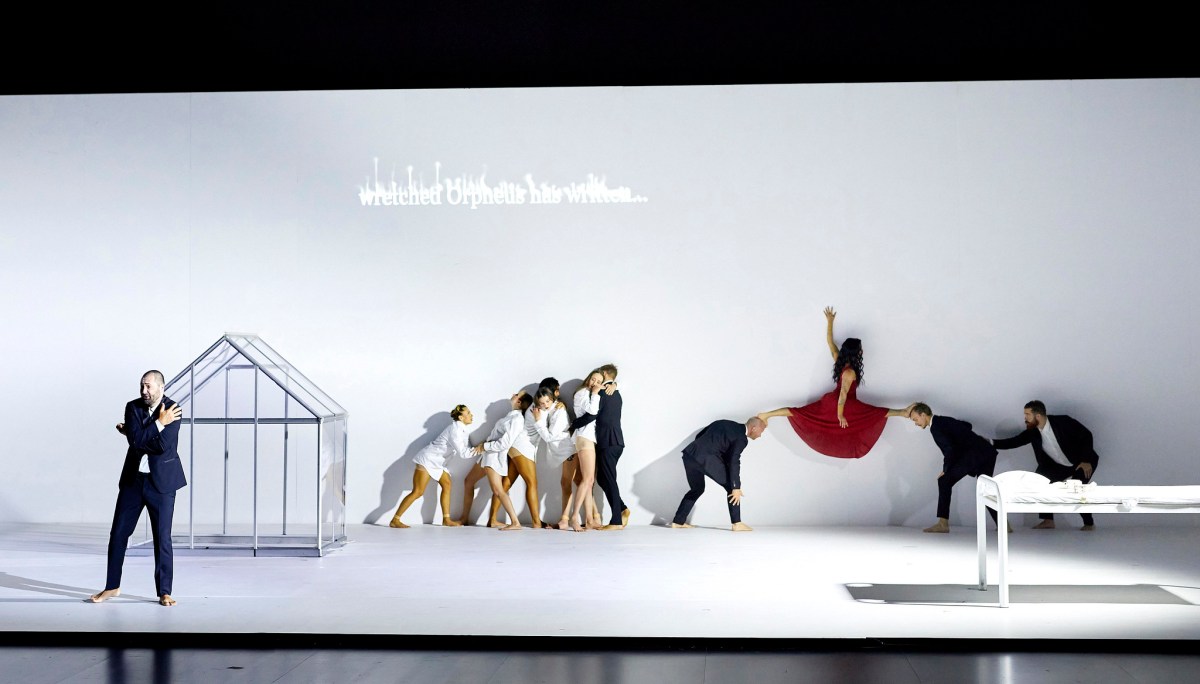Yaron Lifschitz’s production of Handel’s Orpheus & Eurydice for Opera Australia, which premiered at the Sydney Opera House on Friday, is an eye-opener.
Ballet is to early opera, especially French opera, what palate cleansers or amuse-bouches are to high falutin’ restaurants. They have never amused me much, I must admit, especially when they are not part of the plot – unlike if they’re entertainment at parties, for example, such as the scene in La Traviata, the flamenco in Carmen or the dance of the sprites in Rusalka – but rather consist of dancers flitting in and around the singers for no apparent reason.
And how about acrobats? Even those from Lifschitz’s brilliant troupe, Circa? Lord save us.
However, the magnificent acrobats of his company are far from a distraction or a nuisance: instead, they give us an exciting and stirring intensification of the music and the plot. Except for a few minutes towards the end of Eurydice’s aria begging Orpheus to turn and look at her – for me, at least, the only few minutes during which I wished they would get out of the way – they don’t put a step wrong. And, at 80 minutes long, the opera doesn’t give us a chance to tire of the constant action on stage.
Lifchitz has set the opera in an asylum, with Orpheus battling the madness brought on by the death of his wife on their wedding night. The stage is minimal, all white with an occasional prop. Beds figure in the asylum. So does a claustrophobic construction that inexplicably houses the entire chorus at one point, but also contains Orpheus and Eurydice when they’re supposed to be in motion, on the long walk back to Earth. But Orpheus’ moment of painting an insanely triumphant slogan near the end, in blood red on the hospital wall, makes the heart race. And the projection of the surtitles in one place – in black onto the white back wall, making each dissolve into smoke before the next one arrives – is an extra cerebral or emotional touch, depending on how you read it.
‘One way to think about human existence is as a battle between Eros (desire, sex) and Thanatos (death). These two drives wrestle until, inevitably, Thanatos wins,’ Lifschitz writes in his director’s note. ‘I start every project with a question: what is urgent about this project, now? Orpheus & Eurydice, for me, is a project about the viscerality of desire, about what happens when love, lust and loss all get mixed up in our psyches.’
The story of Orpheus & Eurydice comes from Greek mythology and was told by both Ovid and Virgil. The opera is by Gluck and premiered in Vienna in 1762. The libretto here is the original Italian by Ranieri de’ Calzabigi, before the French got their fingers on the work the following century to make it more elegant, as they were wont to do.
And that libretto is a confection of words that could just as well have come from Orpheus’ psyche as from the mythical man literally going to Hell and back to lead his beloved wife back to life. When the sprites are evoked just before Eurydice’s aria, the Circa acrobats aren’t illustrating the words: the words seem to be reporting the emotions the acrobats are evoking.
French countertenor Christophe Dumaux’s Orpheus is superb. His voice has a liquid depth to it unusual for that voice. It compares the way a mezzo-soprano compares to a soprano – and there’s an interesting historical note to that. Berlioz’s 1859 French version was scored for the mezzo-soprano Pauline Viardot instead of any kind of male voice.
Hong Kong-born Sandy Leung was a plucky last-minute stand-in for the more experienced soprano Cathy-Di Zhang on Friday. Leung has sung lesser roles, but is a full-time member of Opera Australia’s Chorus now and this is her first leading role. Her voice blended nicely with Dumaux’s in the long duet of their return journey.
Read: Opera review: Il Tabarro, Sydney Festival
Lifschitz’s production of Orpheus & Eurydice premiered in Brisbane in 2019 to ambivalent reviews. Some complained that the constant activity of the acrobats on stage was a distraction from the singing. As I’ve said already, I’m no fan of distracting movement on stage – I adored Elijah Moshinsky’s Barber of Seville, but after Figaro sang his famous song racing between clients in his barber’s shop, I thought, ‘That was fantastic! Now sing it standing still so I can hear la musica.’ The often-breathtaking movements of Lifschitz’s acrobats, however, blended seamlessly with the music and the emotional state of the grief-crazed hero.
Orpheus & Eurydice
Joan Sutherland Theatre, Sydney Opera House
Opera Australia and Sydney Festival present Opera Queensland’s production of Orpheus & Eurydice in association with Circa.
Conductor: Dane Lam
Director and Set Designer: Yaron Lifschitz
Associate Director: Heather Fairbairn
Costume Designer: Libby McDonnell
Lighting Designer: Alexander Berlage
Projection Designer: Boris Bagattini
Choreography: Yaron Lifschitz, Bride Hooper, Circa Ensemble
Cast: Christophe Dumaux, Sandy Leung (filling in for Cathy-Di Zhang)
Opera Australia Chorus, Opera Australia Orchestra, Circa Ensemble
Tickets: from $79
Orpheus & Eurydice will be performed until 31 January 2024.





